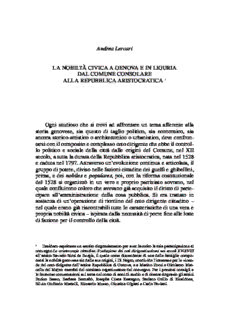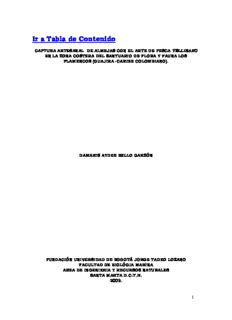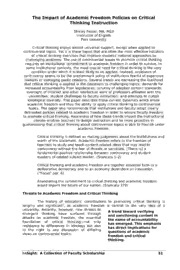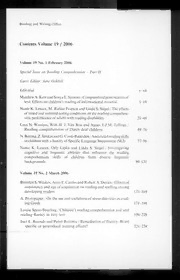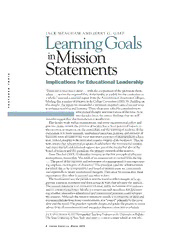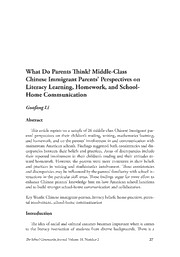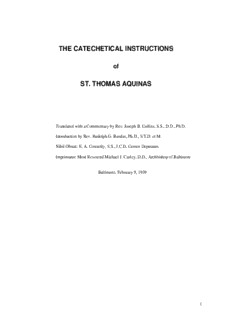
the catechetical instructions st. thomas aquinas - St. Patrick's Basilica PDF
Preview the catechetical instructions st. thomas aquinas - St. Patrick's Basilica
THE CATECHETICAL INSTRUCTIONS of ST. THOMAS AQUINAS Translated with a Commentary by Rev. Joseph B. Collins, S.S., D.D., Ph.D. Introduction by Rev. Rudolph G. Bandas, Ph.D., S.T.D. et M. Nihil Obstat: E. A. Connolly, S.S., J.C.D, Censor Deputatus Imprimatur: Most Reverend Michael J. Curley, D.D., Archbishop of Baltimore Baltimore, February 9, 1939 1 The Catholic Primer Copyright Notice The contents of this document is in the public domain. However, this electronic version is copyrighted. © The Catholic Primer, 2004. All Rights Reserved. This electronic version may be distributed free of charge provided that the contents are not altered and this copyright notice is included with the distributed copy, provided that the following conditions are adhered to. This electronic document may not be offered in connection with any other document, product, promotion or other item that is sold, exchange for compensation of any type or manner, or used as a gift for contributions, including charitable contributions without the express consent of The Catholic Primer. Notwithstanding the preceding, if this product is transferred on CD-ROM, DVD, or other similar storage media, the transferor may charge for the cost of the media, reasonable shipping expenses, and may request, but not demand, an additional donation not to exceed US$10. Questions concerning this limited license should be directed to webmaster@catholicprimer.org . This document may not be distributed in print form without the express prior consent of The Catholic Primer. Adobe®, Acrobat®, and Acrobat® Reader® are either registered trademarks or trademarks of Adobe Systems Incorporated in the United States and/or other countries. The Catholic Primer: www.catholicprimer.org 2 Table of Contents INTRODUCTION..............................................................................................................................6 TRANSLATOR'S PREFACE...........................................................................................................7 ST. THOMAS AQUINAS..............................................................................................................7 CHIEF WORKS OF ST. THOMAS............................................................................................9 THE OPUSCULA..........................................................................................................................9 ST. THOMAS IN THE HISTORY OF CATECHETICS........................................................10 TRANSLATOR'S NOTE............................................................................................................10 INDEX OF KEY TERMS...............................................................................................................12 THE APOSTLES' CREED.............................................................................................................16 WHAT IS FAITH?.......................................................................................................................16 THE FIRST ARTICLE: "I Believe in One God."....................................................................18 SOME MOTIVES FOR BELIEF IN MANY GODS....................................................................19 ERRORS RELATING TO THE FIRST ARTICLE......................................................................20 GOOD EFFECTS OF OUR FAITH...........................................................................................21 THE SECOND ARTICLE: "And in Jesus Christ, His only Son, our Lord."........................22 ERRORS RELATING TO THE SECOND ARTICLE.................................................................23 THE DIVINE GENERATION.....................................................................................................23 THE THIRD ARTICLE..............................................................................................................25 ERRORS RELATING TO THE THIRD ARTICLE.....................................................................25 GOOD EFFECTS OF THESE CONSIDERATIONS.................................................................26 THE FOURTH ARTICLE: "Suffered under Pontius Pilate, was crucified, died and was buried.".........................................................................................................................................28 EVIL EFFECTS OF SIN............................................................................................................29 CHRIST, EXEMPLAR OF VIRTUES.........................................................................................30 THE FIFTH ARTICLE: "He Descended into Hell."...............................................................31 REASONS FOR CHRIST'S DESCENT......................................................................................31 WHAT WE MAY LEARN FROM THIS......................................................................................32 SPECIAL CHARACTER OF CHRIST'S RESURRECTION.......................................................34 WHAT WE MAY LEARN FROM THE RESURRECTION.........................................................35 THE SIXTH ARTICLE: "He ascended into heaven, and sitteth at the right hand of God, the Father Almighty.".................................................................................................................36 THE SUBLIMITY OF THE ASCENSION..................................................................................36 THE REASONABLENESS OF THE ASCENSION.....................................................................36 THE BENEFITS OF THE ASCENSION....................................................................................37 THE SEVENTH ARTICLE: "From thence He shall come to judge the living and the dead."............................................................................................................................................38 THE FORM OF THE JUDGEMENT.........................................................................................38 WHO ARE TO BE JUDGED?...................................................................................................38 THE FEAR OF THE JUDGMENT............................................................................................39 OUR PREPARATION FOR THE JUDGMENT.........................................................................40 THE EIGHTH ARTICLE: "I Believe in the Holy Ghost.".....................................................40 TEACHING OF THE NICENE CREED....................................................................................41 BENEFITS FROM THE HOLY GHOST....................................................................................41 THE NINTH ARTICLE: "I Believe in the Holy Catholic Church."......................................43 THE UNITY OF THE CHURCH...............................................................................................43 THE HOLINESS OF THE CHURCH........................................................................................43 THE CATHOLICITY OR UNIVERSALITY OF THE CHURCH................................................44 THE APOSTOLICITY OF THE CHURCH................................................................................44 THE TENTH ARTICLE: "The Communion of Saints, the Forgiveness of Sins."...............46 THE SEVEN SACRAMENTS: A REVIEW.................................................................................46 THE FORGIVENESS OF SINS..................................................................................................47 3 THE COMMUNION OF SAINTS..............................................................................................47 THE ELEVENTH ARTICLE: "The Resurrection of the Body."...........................................48 THE BENEFITS OF THE RESURRECTION............................................................................49 QUALITIES OF THE RISEN BODIES......................................................................................49 CONDITION OF THE BLESSED..............................................................................................50 CONDITION OF THE DAMNED..............................................................................................50 THE TWELFTH ARTICLE: "Life everlasting. Amen."........................................................51 WHAT IS EVERLASTING LIFE?..............................................................................................51 THE FULLNESS OF DESIRES.................................................................................................52 WHAT IS EVERLASTING DEATH?..........................................................................................52 EXPLANATION OF THE TEN COMMANDMENTS................................................................54 THE TEN COMMANDMENTS.................................................................................................54 THE FIRST COMMANDMENT: "Thou Shalt Not Have Strange Gods Before Me."........54 WHY WE SHOULD ADORE ONE GOD...................................................................................55 SECOND COMMANDMENT: "Thou Shalt Not Take the Name of the Lord Thy God in Vain."............................................................................................................................................58 THE MEANING OF IN VAIN....................................................................................................58 CONDITIONS OF A LAWFUL OATH......................................................................................59 TAKING GOD'S NAME JUSTLY...............................................................................................59 THE THIRD COMMANDMENT: "Remember that You Keep Holy the Sabbath Day."...62 REASONS FOR THIS COMMANDMENT.................................................................................62 FROM WHAT WE SHOULD ABSTAIN ON THE SABBATH....................................................63 WITH WHAT THE SABBATH AND FEASTS SHOULD BE OCCUPIED................................64 THE SPIRITUAL SABBATH......................................................................................................65 THE HEAVENLY SABBATH[62]..............................................................................................65 THE FOURTH COMMANDMENT: "Honour thy father and thy mother, that thou mayest be long-lived upon the land which the Lord thy God will give thee.".....................................68 WHAT CHILDREN OWE PARENTS.........................................................................................69 REWARDS FOR KEEPING THIS COMMANDMENT..............................................................70 THE DIFFERENT APPLICATIONS OF FATHER....................................................................70 THE FIFTH COMMANDMENT: "Thou Shalt Not Kill.".....................................................73 THE SIN OF KILLING..............................................................................................................73 THE SIN OF ANGER.................................................................................................................74 THE SIXTH COMMANDMENT: "Thou Shalt Not Commit Adultery.".............................78 WHY ADULTERY AND FORNICATION MUST BE AVOIDED...............................................79 THE SEVENTH COMMANDMENT: "Thou Shalt Not Steal."............................................81 WHY STEALING MUST BE AVOIDED....................................................................................82 THE EIGHTH COMMANDMENT: "Thou Shalt Not Bear False Witness Against Thy Neighbour."..................................................................................................................................84 WAYS OF VIOLATING THIS COMMANDMENT.....................................................................84 SPECIAL EFFECTS OF TELLING LIES..................................................................................85 THE NINTH (TENTH) COMMANDMENT: "Thou shalt Not Covet Thy Neighbour’s Goods.".........................................................................................................................................87 THE TENTH (NINTH) COMMANDMENT: "Thou Shalt Not Covet Thy Neighbour’s Wife."............................................................................................................................................89 WAYS TO OVERCOME CONCUPISCENCE............................................................................90 SUMMARY OF THE TEN COMMANDMENTS....................................................................91 EXPLANATION OF THE LORD'S PRAYER.............................................................................92 FIVE QUALITIES OF PRAYER...............................................................................................92 THE OPENING WORDS OF THE LORD'S PRAYER..........................................................94 PREPARATION FOR THE PETITIONS....................................................................................94 THE PREEMINENCE OF GOD................................................................................................95 THE FIRST PETITION: "Hallowed Be Thy Name."..............................................................99 GOD'S NAME IS LOVABLE......................................................................................................99 4 GOD'S NAME IS VENERABLE.................................................................................................99 GOD'S NAME IS INEFFABLE..................................................................................................99 MEANING OF HALLOWED...................................................................................................100 THE SECOND PETITION: "Thy Kingdom Come."............................................................101 WHY WE PRAY THUS.............................................................................................................101 WHY WE DESIRE THIS KINGDOM.......................................................................................101 THE THIRD PETITION: "Thy Will Be Done on Earth as It Is in Heaven.".....................103 THE WILL OF GOD................................................................................................................104 WHAT DOES GOD WILL?......................................................................................................104 THE COMMANDMENTS: GOD'S WILL................................................................................104 LET THY WILL BE DONE.......................................................................................................105 THE FOURTH PETITION THE FOURTH PETITION "Give Us This Day Our Daily Bread."........................................................................................................................................107 THE FIFTH PETITION: "And Forgive Us Our Trespasses As We Forgive Those Who Trespass Against Us."................................................................................................................110 WHY DO WE MAKE THIS PETITION?..................................................................................110 THE FULFILLMENT OF THIS PETITION............................................................................111 WHAT MUST WE DO?............................................................................................................111 THE SIXTH PETITION: "And Lead Us Not Into Temptation.".........................................113 WHAT IS TEMPTATION?.......................................................................................................113 HOW IS ONE TEMPTED?......................................................................................................114 SEVENTH PETITION: "But Deliver Us from Evil. Amen."................................................116 THE VALUE OF PATIENCE...................................................................................................117 A SHORT EXPLANATION OF THE WHOLE PRAYER...................................................117 THE HAIL MARY.........................................................................................................................119 THE ANGELIC SALUTATION..............................................................................................119 "HAIL MARY"..........................................................................................................................119 THE ANGEL'S DIGNITY.........................................................................................................119 "FULL OF GRACE"................................................................................................................119 VIRTUES OF THE BLESSED VIRGIN...................................................................................120 MARY, HELP OF CHRISTIANS..............................................................................................120 "THE LORD IS WITH THEE".................................................................................................120 "BLESSED ART THOU AMONG WOMEN"...........................................................................121 "BLESSED IS THE FRUIT OF THY WOMB".........................................................................121 QUESTIONS FOR DISCUSSION...............................................................................................124 5 INTRODUCTION Some are of the opinion that the teaching of religion requires no preparation and that anything is good enough for the child. Asking catechism questions and listening to the child's recitation of the memorised answers--exercises which are considered as constituting the whole process of catechisation--are in their estimation, after all, very simple tasks. And if the child stumbles and hesitates, a little prompting will elicit the desired answer. Unfortunately these exercises of verbal memory, instead of inflaming the child with a love of God, leave him as cold as do the drills of the multiplication table. The unassimilated abstract forms, instead of promoting spiritual growth, become non-functional memory loads. Religion, presented by methods such as these, strikes the child as a mere formality and as a hard law, and he applies himself to it more out of necessity than out of love and a joyous enthusiasm. The teacher must carefully prepare the religion lesson if he wishes to give an accurate and adequate explanation of the catechismal truths. The child's intellectual powers are not sufficiently developed to grasp correctly a religious truth without appropriate explanations. The adult has by experience acquired many ideas and can interpret the new in terms of the old. But this is not true of the child. For him the bread of divine truth and life must be broken slowly. At the same time his mind is an "unmarked virgin slate" which registers new impressions with the pliability of wax and retains them with the durability of marble. If a child, through a faulty presentation on the part of the teacher, assimilates an erroneous idea in his early years, he may retain it for the rest of his life. The child will be confirmed in his error by the teacher's authority, which he accepts unquestioningly, and by his own imitative tendency which makes him readily repeat whatever the teacher says. If the instructor is to be a messenger of truth and not of error, he must have access to doctrinal commentaries in which the truths of faith are explained in a simple, accurate and authoritative manner. The catechist must supply those concrete explanations which the Catechism and religion books are obliged in their brevity to leave out. Theological manuals in use by priests and seminarians usually state a thesis and then prove it from the infallible decrees of the Church, from the Scriptures and Fathers, and finally from reason. The thesis should logically be placed at the end of such a discussion, since it is an abstract conclusion based upon many concrete facts. The doctrinal statements in our Catechisms and religion books are also conclusions--conclusions based upon facts derived from various sources. To expect the child to grasp these abstract formulas without first becoming acquainted with the concrete facts on which they are based, is to expect greater intellectual acumen in the child than in the theologian. Catechists must with the help of appropriate handbooks build up the rich doctrinal background which the Catechism and religion books presuppose. In his translation entitled "The Catechetical Instructions of St. Thomas Aquinas," the Rev. Joseph B. Collins, S.S., S.T.D., Professor of Theology and Catechetics at the Catholic University of America, has made available to teachers of religion a theologically accurate explanation of the Catechism. It is Dr. Collins' latest contribution to the catechetical movement in America. The appearance of this translation of St. Thomas' catechetical works will be greeted with genuine satisfaction by all. In these days of renewed interest in Thomism, especially on the part of laymen, it will be comforting to know that the vast knowledge of the Church's greatest theologian is now made accessible--in a condensed and simple form--not only to teachers of religion but to the laity at large. 6 The work presents several peculiarities. Suggestive of the medieval custom of dividing the contents of catechetical manuals, the work contains an explanation of the Creed, the Sacraments, the Commandments, the Our Father, and the Hail Mary. The principle of doctrinal correlation is frequently in evidence. Thus, a brief explanation of the Sacraments is correlated with the Tenth Article of the Creed--"The Communion of Saints, the Forgiveness of Sins"; for it is through the Sacraments that Christ, our Head, communicates graces to the members of His Mystical Body. As in the great theological syntheses of the Middle Ages, the presentation of truth is comparatively cold and abstract. The medieval theologians deemed it inadvisable to appeal to the imagination and to the emotions in the quest of truth. But they were by no means unacquainted with the ethical appeal of the truths they were discussing. In no one's career, perhaps, was the golden thread of doctrine so closely woven into the tissues of a perfect life as in that of St. Thomas. Of him it may be said that he wished to know in order that he might love; then, because he loved, he wished to scrutinise ever more closely the object of his affections. His sublime hymns on the Eucharist are best proof that lofty speculation does not suppress or warp the affective element in human nature. To-day, as in other ages, "truths are decayed, they are diminished among the children of men." The environment in which we live and the atmosphere which we breathe are tainted with irreligion and unbelief. May the perusal of this book produce in the readers that strong faith, fond hope, and burning love of God which animated the soul of the great theologian, the Angelic Doctor, St. Thomas Aquinas! RUDOLPH G. BANDAS, S.T.D. ET M. TRANSLATOR'S PREFACE ST. THOMAS AQUINAS St. Thomas Aquinas was born about the year 1225.1 The name Aquinas derived from the territory of his father, Count Landulf of Aquina, in the vicinity of Naples. The mother of Thomas was Theodora, Countess of Teano, and his family was related to the Emperors Henry VI and Frederick II, and to the Kings of France, Aragon, and Castile. "He could have quartered half the kingdoms of Europe in his shield," wrote Chesterton, "if he had not thrown away the shield. He was Italian and French and German and in every way European."[2] At the early age of five Thomas was sent to school at the Benedictine Monastery of Monte Cassino. He showed at once the great gifts of intellect with which he had been endowed. His biographers attest to the piety and inquiring nature of this young pupil, who would surprise his master with the oftrepeated question: "What is God?" The early Benedictine training left Thomas with a life-long devotion to the Liturgy, and prepared him for further studies at the famed University of Naples where he was enrolled in or about the year 1239. While at Naples Thomas met with the members of the Order Or St. Dominic, which had been founded some twenty years earlier. He made known his desire to be a Dominican about 1240, and instantly met with strong opposition from his family, but especially from his mother. At length he received the Dominican habit in April, 1244, and was chosen to continue his studies at the Dominican school of studies at the University of Paris. Countess Theodora completely disapproved of this journey, and sent two of her sons and a detachment of soldiers to intercept Friar Thomas on his way to Paris. In this she was successful, and for nearly two years he was held a virtual prisoner in the family castle. This period was well spent by Thomas in study and meditation. Here he was constantly urged to forsake his vocation, and on one occasion he was tempted by a woman who had been thrust into his chamber by his own brothers. Thomas arose and grasping a burning brand from the fire, forced the temptress from his room. Then with characteristic vigour he burned deep in the door the potent sign of the cross. In 7 later years he confided to his secretary and companion, Reginald of Piperno, that immediately after this event he as granted his urgent prayer for the gift of perpetual chastity, and thereafter had complete freedom from the motions of concupiscence. : seems probable that this gave first basis for his title of Angelic Doctor. In 1245 St. Thomas began to attend the lectures in theology of St. Albert the Great at the University of Paris. He made extraordinary progress in his studies, and three years later he accompanied St. Albert to Cologne there to continue his study. He was engaged n teaching in 1250. This same year marks his ordination to the priesthood. Thomas accompanied his teacher, Albert the Great, back to Paris in 1252, where he continued his lecturing and at the same time prepared for the examinations for the degree of Master n Theology. He was awarded the degree in 1257 from the University of Paris. He continued to lecture at this world-famous institution during these early years in his career, which was marked by developing intellectual power and originality and growing familiarity with the vast field of theological and philosophical learning. St. Thomas was called to Rome in 1259, and for nine busy years was teaching, lecturing, and writing as the theologian of the Papal Court. He continued his study of Aristotle, and was deeply engrossed in the literature of the Fathers of the Church. "He worked with the spirit of a missionary," says Martian, "in the cause of Truth against error."[3] His chief writings of this period were a number of philosophical works, commentaries on various Books of the Old and New Testaments, theological disputations; above all, in 1267 or 1268 he completed the First Part of his masterpiece, the "Summa Theologica." St. Thomas was already widely known as a great theologian and scholar in this century which abounded in great theologians and scholars. Recalled to Paris to replace a stricken Master of Theology at the University, he began the last period of his life. He was to live less than six more years. They were crowded years of writing, teaching, and preaching. His Sermons, which fill a good-sized volume, were begun in the early years of his priestly life, and he continued to preach until his death. He was an authority on the spiritual life, and personally experienced the trials and consolations of the trained ascetic and the true contemplative. His writings on ascetic and mystical theology are original and permanent contributions to the science of the Saints. It is related of him that, after having written the sublime treatise on the Holy Eucharist, he was seen to fall into an ecstasy, and a voice from the crucifix above the altar was heard to say: "Thou hast written well of Me, Thomas. What reward wilt thou have?" To this the Saint replied: "None, Lord, other than Thyself." Thomas remained in Paris for three years, from 1269 to 1272,4 in the full maturity of his powers and the manifold outpourings of his genius. All of the Second Part of the "Summa Theologica" was written at this time, and the Third Part was begun. In 1272 he was recalled to Naples by order of the king to teach at the University of Naples which he had attended as a boy. He put the finishing touches on his numerous projects, completed the Third Part of the "Summa" up to Question XC, and then laid down his pen already worn out at the early age of 48. "I can do no more," he said on the morning of December 6, 1273. He had experienced an ecstasy during Mass and said to Reginald, his secretary: "Such secrets have been revealed to me that all I have written now appears of little value." During the following Lenten season, Thomas gave to the students and townsfolk of Naples the series of catechetical instructions on the Creed, Commandments, and Prayer which make up part of this volume. They are his last words. He died on March 7, 1274, at Fossanuova in Northern Italy while on his way to attend the Council of Lyons. St. Thomas Aquinas lived in an age of great scholars and great Saints. He is the "prince and Master of all."[5] St. Thomas was canonised in 1323. St. Pius proclaimed him a Doctor of the Universal Church in 1567. When Pope Leo XIII wrote his famous Encyclical, "Aeterni Patris," on the restoration of Christian philosophy, he urged his readers with all the force of his apostolic office "to restore the 8 golden wisdom of St. Thomas and to spread it far and wide for the defence and beauty of the Catholic Faith, for the good of society, and for the advantage of all sciences." The same Pontiff, in a Brief dated August 4, 1880, designated St. Thomas Patron of all Catholic universities, and his successors, including Pope Pius XI, have ordered Catholic teachers to make the explanations of Christian Doctrine by St. Thomas the basis for all their teaching. CHIEF WORKS OF ST. THOMAS More than sixty separate works, some of great length and some brief, came from the fertile mind of the Angelic Doctor.[6] Most important and, one would wish, most familiar of all his writings is the "Summa Theologica." This is a complete scientific exposition of theology and at the same time a summary of Christian philosophy. St. Thomas considered this work simply as a manual of Christian Doctrine for the use of students. He thus announced its division: "Since the chief aim of this sacred science is to give a knowledge of God, not only as He is in Himself, but also as He is the Beginning of all things and the End of all, especially of all rational creatures--we shall treat first of God; secondly, of rational creatures' advance towards God; thirdly, of Christ who as Man is the Way by which we tend to God." These are the leading ideas of his "Summa," and upon them he based the three Parts of this great work. The "Summa contra Gentiles," whose full title is "Treatise on the truth of the Catholic Faith against Unbelievers" (1258-1261), is the most profound and doubtless the most powerful apologetically work ever written. It is St. Thomas' "Summa philosophica," taking philosophy in the modern sense. The long list of Commentaries on the Sacred Scriptures are exhaustive, of great depth, and of permanent value. The "Perfection of the Spiritual Life" is one of the classics in the field of ascetical and mystical theology, and together with pertinent parts of the "Summa" forms a complete explanation of the Christian higher life.[7] St. Thomas also wrote the admirable "Office for the Feast of Corpus Christi" with its familiar prayers and hymns.[8] THE OPUSCULA The "Opuscula" or "Little Treatises" are very numerous. In the course of time works were listed among the "Opuscula" which were not written by St. Thomas. In the "official" catalogue of Reginald of Piperno the "Opuscula" number seventy. They may be roughly classified as philosophical and theological, on moral and canonical questions, on Liturgy and the religious life, and catechetical instructions. There are some "Opuscula" not listed in the "official" catalogue which are now considered authentic. The five "Opuscula" which are translated in the present volume are undoubtedly authentic." The Explanations of the "Creed," the "Our Father," and the "Ten Commandments" are numbers 66, 65, 68 respectively in the catalogue which was prepared for the process of canonisation of St. Thomas. The Explanation of the "Hail Mary" is listed in the catalogue of Bernard Guidonis and in later lists. This is noteworthy, since Bernard had before him the official list. Both Mandonnet and Grabmann consider the work authentic.[10] St. Thomas gave these Explanations to the students and people of Naples during his last Lenten season on earth. The talks on the Ten Commandments were written down by Peter d'Andrea, and the Explanation of the other prayers were faithfully reported by his secretary and companion, Reginald of Piperno. The "Explanation of the Seven Sacraments" is the second part of the treatise, "De fidei articulis et septem sacramentis," which St. Thomas wrote at the request of the Archbishop of Palermo in 1261- 62. It is noteworthy that the famed "Decretum pro Armenis" (Instruction for the Armenians), issued by the authority of the Council of Florence, is taken almost verbatim from the second part of this "Opusculum" (i.e., the "Explanation of the Seven Sacraments"). It is not a definition of the Council, but a practical instruction, as Denzinger points out.[11] 9 The latest editions of the "Opuscula" are the Vives edition (Paris) of 1871-80 and the Parma edition of 1852-73. This latter edition is reedited by Mandonnet with a new order and an introduction (Lethielleux, Paris, 1927). The "catechetical" "Opuscula" are here given in one volume in English for the first time. An English translation of two of these under the title, "On the Commandments" and "On the Lord's Prayer," was made by the Reverend H. A. Rawes in England in 1891. It is now out of print and practically inaccessible. Recently an English translation was made by Rev. Lawrence Shapcote, O. P., in two small volumes with the titles, "The Three Greatest Prayers" and "The Commandments of God" (Burns and Oates, 1937). The "Explanation of the Seven Sacraments," however, is here given for the first time in English. ST. THOMAS IN THE HISTORY OF CATECHETICS The original and traditional meaning of "catechesis" (from the Greek: teaching by word of mouth) was oral teaching or instruction by word. It is used in this sense in the New Testament (e.g., in Luke i. 4; Acts, xviii. 25). "Catechetical" referred solely to this form of oral explanation of Christian Doctrine. This is the meaning that "catechetical instruction" had in the time of St. Thomas and throughout the Middle Ages.[12] "In this connection," says one authority, "it must be remembered that the term 'catechetical' was very often applied to sermons and instructions for grown people, not for children."[13] The conception of "catechetical" and "catechism" as referring to the question and answer method of teaching became general only during the Counter-Reformation. Thus, St. Augustine's classic work on teaching religion, "De rudibus catechizandis" (On Instructing the Ignorant), is straight exposition without question and answers. The famed "Roman Catechism" (Catechism of the Council of Trent) is not in question and answer form. Hence, the catechetical instructions of St. Thomas, which are oral explanations of Christian Doctrine, entitle him to a place in the history of catechetics with St. Augustine, Gerson, St. Charles Borromeo, St. Peter Canisius and others.[14] The method of explaining Christian Doctrine by giving detailed attention to the Creed, the Commandments, the Our Father and Hail Mary, goes back to the early centuries of the Church. One of the first great works which embody this fourfold division is the "Catechetical Instructions" of St. Cyril of Jerusalem (d. 386). This division became general throughout the medieval period, and the "Creed, Code, Sacraments and Prayer" came to be a formula of the faith. Numerous Synods and Councils of the Church at this time decreed that sermons and instructions must be given the faithful according to this fourfold division.[15] The "Roman Catechism" follows this arrangement, as do most of the Catechisms of modern times. The catechetical instructions of St. Thomas were used generally throughout the thirteenth and fourteenth centuries as manuals and text-books for priests and teachers of religion.[16] "The Explanations of St. Thomas," wrote Spirago, "are remarkable for their conciseness and their simplicity of language; they are especially noteworthy because the main parts of the catechetical course of instruction are brought into connection with one another so that they appear as one harmonious whole."[17] The influence of these works is especially prominent in the "Roman Catechism" which the Council of Trent ordered written for parish priests and for all teachers of religion. Many of the explanatory passages in both works are almost identical. TRANSLATOR'S NOTE The edition used in this translation is the Parma, edited by P. Mandonnet, O. P., "Opuscula Omnia" (Lethielleux, Paris, 1927). Where the Vives edition is used, the change is noted in the footnotes. The edition of the "Roman Catechism" (Catechism of the Council of Trent) used in the commentary is "Catechismus Concilii Tridentini ad Parochos," Romae, Ex Typog. Polyglotta, S. Cong. de Prop. Fide, 1891. To Reverend E. A. Connolly, S. S., for reading the manuscript and for many helpful suggestions the Translator is very grateful. 10
Description:The list of books you might like

The 48 Laws of Power

As Good as Dead

Mind Management, Not Time Management

The Spanish Love Deception

By Invitation Only: Exclusively Yours Private Party Secret Encounter

NASA Technical Reports Server (NTRS) 20060047794: An Exercise in Technology Prioritization in a Competitive Environment
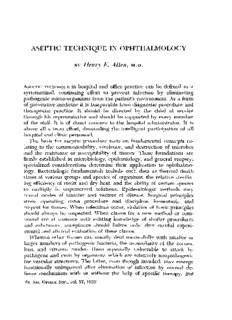
BY Henry F. Allen, MD
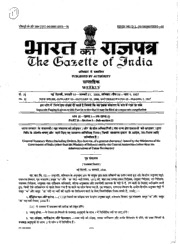
Gazette of India, 2006, No. 207
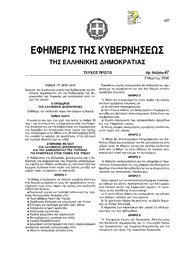
Greek Government Gazette: Part 1, 2006 no. 47
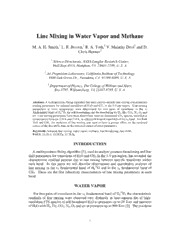
Line Mixing in Water Vapor and Methane

Opportunities in vocational & technical careers
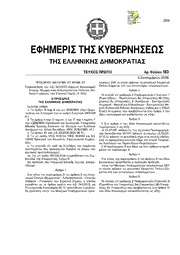
Greek Government Gazette: Part 1, 2006 no. 183

Long Lived States In Collisions
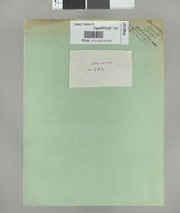
Vitis vinifera subsp. vinifera cv. Caladoc
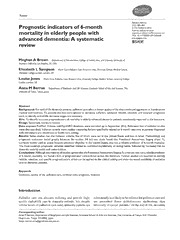
Prognostic indicators of 6-month mortality in elderly people with advanced dementia: A systematic review.

Premesse a Cassandra
